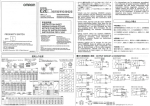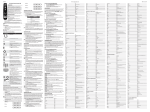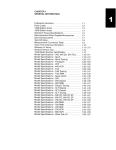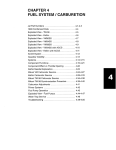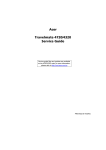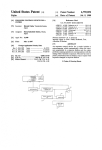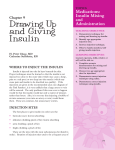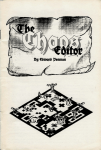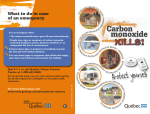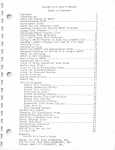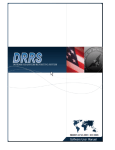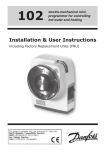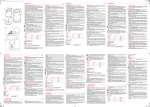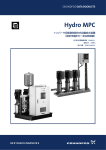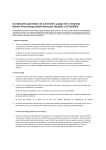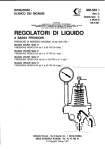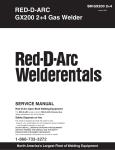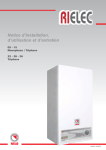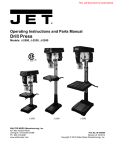Download SERVICt:: TEXTBOOK
Transcript
~ JOHN DEERE uP- DATED SERVICt:: TEXTBOOK for JOHN DEERE 340 Liquidator , . :. . Litho in U.S. A. 1-6 " .. .;" .:"';':'~. '. '. '. . ?:>%~:~ . . -:,.; '." ,~,,!,t;~~ M67054 CONTENTS LIQU IDATOR PROGRAM 270M ......... . SPECIFICATIONS . .................. 3 ENGINE ........................... 5 FUEL SYSTEM ............•....••... 10 ELECTRICAL SYSTEM ..•...........•• 11 POWER TRAIN . •..••..........••.... 20 SUSPENSION ..•...........• •... •.•• 26 LIQUIDATOR REBUILD PROGRAM 270M 1976 340 Liquidator (Serial No. 55,001-70,000) The 1976 340 Liquidator did not perform as expected, re sulting in some dissatisfied customers. This rebuild program was implemented to correct the premature piston scoring, clutch failure, and structural failures encountered in this past season. The following parts are listed for your information as to what went into your 1976 Liquidator under the rebuild program . .IIIIt";; *1. Engine Kit Parts 8. New primary drive clutch. New, specially cammed pistons with rings. 9. Improved carburetor venting. *2. New cylinder assembly with new bore size. *3. New gaskets. *4. New piston pin needle bearings. *5. New thermostat. *6. Carburetor main jet changes. 7. Improved cooling system by-pass and a 11 new hoses. - 1 - *10. New rebui lt water pump. *11. Rebuilt and new ignition system. *12. New fuel pump and hoses. 13. New carburetors (See page 11 for new pa rts added). 14. New lower engine hose. NOTE: * Pald6 not. .6 hown. Kit Parts 1. New front frame. 6. New drive belt. 2. New engine base plate and mounts. 7. New reinforcement, R.H. 3. New fuel pump bracket. 8. 4. New aluminum belt guard and bracket. 5. New snow flap and support. Bag of parts. Includes the following: new tensioner and spring assembly, new ski bolts, rail reinforcement bars, torque buttons, new brake pads, new chain case cover seal, all new hardware washers, bolts, nuts, cotter pins, and pop rivets. The above parts will be installed on all snowmobiles. In addition the suspension and other related components will be checked for cracks and welded if necessary. New coolant will be added to the cooling system. Chaincase oil will be replaced and the secondary torque buttons will be epoxied in place. The snowmobile will be run on a chassis dyno for final performance check. -2- SPECIFICATIONS COMPONENT ENGINE SPECIFICATIONS ITEM JD/Kioritz KEC 340 RS 24/LC Manufacturer Model No. of Cylinders Bore Stroke Displacement Cooling 60 mm 60 mm 339 cc Liquid FUEL SYSTEM Carburetor Fuel Mixing Ratio Mikuni VM 36 (2 used) 50:1* ELECTRICAL SYSTEM Ignition Spark Plug Timing (Dynamic) Lighting Coil Capacity WICO, Capacitor Discharge Champion QN-19V (AM53787) 0.065 inch (17 0 ) BTDC 120 Watt POWER TRAIN Clutch Seconda ry Clutch Engagement Engine Maint. Speed Final Drive Ratio: Standard Optional Brake Dri ve Belt Comet 102CS John Deere 4000 rpm (Max.) 8000-8500 rpm 1.67:1,2.05:1, 2.47:1 Mechanical Disk M66345 TRACK AND SUSPENSION Suspension Type Track Width Length Slide (Wheel Kit Optional) Gates Poly Grouser 15.4 inches 121 .73 inches, 3. 29 pitch CHASSIS AND BODY Material: Tunnel and Pan Hood Windshield Overall Length Overa 11 Wi dth Overa 11 Hei ght Ski Stance Wheelbase Weight (lb s.) (w/coolant) Aluminum Fibergl ass Polycarbonate 107.5 in. 40 in. 39 in. 32 in. 72 in. 500 lbs. CAPACITIES Fuel Type Coolant Type 2 1. 86: 1 8.00 U.S . Gallons Premium Grade 4.0 Quart 50/50 Solution Ethylene Glycol/Water 5 ounces, SAE 30 Chaincase *With John Deere snowmobile oil and Premium Grade gasoline. fi rst tankful. - 3 - Use 40:1 ratio for DETAILED ENGINE SPECIFICATIONS ITEM NEW PART DIMENSION WEAR TOLERANCE Cyl i nder Bore 2.365 to 2.366 in. 2.371 in. Connecting R.od (Sma 11 End) 0.9058 to 0.9063 in. 0.9071 in. Connecting Rod Side Clearance (Large End) 0.013 in. 0.024 in. Crankshaft Runout (Max. ) - ------ - 0.003 in. Crankshaft End Play (Max. ) ------ -- 0.024 in. Piston at Ski rt 2.3575 to 2. 3583 in. 2.350 in . Piston Pin Bore 0.7476 to 0.7487 in. 0.7500 in. Piston Pin 0.7477 to 0.7480 in. 0.7461 in. Compression Pressure* llO to 130 ps i *Check compression with engine cold and throttle in wide open position. should not vary by more than 10 psi between cylinders. TORQUE SEQUENCE TORQUE SPECIFICATIONS Cylinder Heads ..... 8 mm - 175 in- lbs 10 mm - 260 in- lbs Crankcase .......... 260 in-lbs Flywheel ........... 60 ft-lbs @ - 4- @ Pressure ENGINE The Kioritz 340 RS 24/LC engine is a totally new engine in the John Deere line and has the following features: 1. 2. 3. Liquid Cooling - This results in increased and more consistent power output, increased reliability, better fuel economy and lower sound levels . Twin Carburetors - The two VM- 36 Mikuni slide valve carburetors provide better breathing for increased power. Capacitor Discharge Ignition - Wico CD ignition provides quicker starting, reduced plug fouling, and features surface gap spark plugs to eliminate spark plug induced pre- ignition. 4. Piston - Ported - To provide high output at high rpm. 5. Twin Expansion Pipes To provide a broader power band. Forged Pistons - these feature high strength, high silicone aluminum alloy with specially cammed and profiled skirts. Skirts are finished with a waved surface for better oil retention and lower friction. Two chrome half keystone piston rings are fitted for improved sealing and life. (See Page 9.) 6. - 5 - 7. Crankshaft - The crank is fitted with six main bearings for better support and features full circle throws for better balance and breathing. 8. Cast Iron Liners - To provide increased 1ife. 9. PTO Seal Guard - To protect seal from failed drive belts and to better retain the seal. IMPORTANT: Due to the high output of this engine, the following precautions must be taken to prevent engine failure: 1. Use only Premium Grade leaded gasoline. 2. Mix gasoline and oil in a 50:1 ratio. (40:1 for first tankful). 3. Proper. break-in is critical. DO NOT exceed 40 mph for the first 25 miles, nor force machine at full throttle in deep snow. An occasional burst of full power on hard packed snow will not be harmful. 4. Always warm- up engine prior to making a high-speed run. 5. Keep cooling system full, coolant pump belt tight, and radiator clean. Never allow temperature gauge needle to move out of yellow and into red zone. Shut down or increase travel speed with reduced load if this occurs. COOLING SYSTEM Operation Draining System The normal flow of coolant is from the radiator to the coolant pump, through the cylinders and cylinder heads, across the thermostat and then back to the radiator for cooling. Remove radiator pressure cap and remove lower engine hose to drain block. Flush sled with water after draining. Cleaning System When the thermostat is closed (below After draining, remove radiator hoses 140 0 F.), coolant is not circulated and back flush radiator with clean through the radiator. The pump circulates water. Do not use flushing additives. coolant through only the engine using the by-pass hose. Fi 11 i ng System When system pressure builds beyond 14-17 psi (cap pressure) some coolant passes the pressure cap and is caught in the coolant recovery container. When the system cools, this coolant is pulled back into the radiator. 1. Remove bleed screws from cylinder head (1) and radiator. 2. Fill systelll until coolant runs out cylinder head bleed port. Install bleed screw and continue to fill until coolant runs out radiator port. Install final bleed screw and fill radiator to top, continue to fill until coolant runs into coolant recovery container, (Approx. 1/2 full). Install pressure cap. 3. Run for 5 minutes or to 140 0 on temperature gauge. Let cool and check coolant for proper level. Coolant Use ethylene glycol anti-freeze mixed 50/50 with clean water. This provides protection to -40 0 Fahrenheit. Do not use rust inhibitors, stop leak, or any other additives in the cooling system. - 6- NOTE: The c.ooun.g .6lj.6.tem pll.e.6.6Wl..e .te.6.tett .6hown. in .the 6oUowing .te.6U .L6 a .6.ta.ndalld automotive unit available .thll.ough Veette GaJtd M nwnbett JDM- 77. REPLACING THERMOSTAT TESTING PRESSURE CAP 1. Drain system. 1. Install radiator pressure cap into tester as shown above. 2. Remove outlet housing and remove thermostat. 2. Apply pressure to cap. Air should not leak past cap seal until 14-17 psi is reached. If it does, replace cap. 3. Thermostat can be tested as follows: TESTING SYSTEM 4. 1. Connect pressure tester to radiator as shown above. 2. Pressurize system to 20 psi and shut off valve. 3. If system will not hold 20 psi without leakback, look for leaks at hose connections, coolant pump, cylinder heat, etc. - 7 - a. Suspend thermostat and thermo meter in a container of water. b. Heat and stir water. c. Thermostat should begin to open at l40 o F. It shoul d be fully open (approx. 1/4 inch) at 162 o F. d. Remove thermostat and observe closing. Reinstall in opposite order, using a new gasket. Be certain temperatures sensing portion of thermostat is installed into cylinder head as shown above. Disassembly PUMP BELT TENSION 1. Remove pull ey bracket by pressing shaft out of bracket. 2. Press the bearing, seal and impeller out bottom of housing. 3. Press bearing out of impeller. Assembly 1. Remove pump cover. 2. Belt should deflect no more than 3/8" when deflected midway between sheaves. 3. PW~P 1. Press new seal into housing . 2. Coat bearing with light oil and press bearing outer race until it is flush with the top of the housing. 3. Press pulley bracket onto bearing shaft until flush . 4. Press impeller onto bearing shaft until approximately 0.009 inch clearance is provided between impell er and housing. Impeller must rotate freely after assembly. Tighten belt by loosening three pump attaching nuts and pivoting pump upward at rear. Tighten nuts. REPAIR EXHAUST SYSTEM 3/32" brazing rod Wrap handle with tape loop l. 2. 3. 4. 5. Cap Screw Cover Gasket Impeller Seal ® 6. 7. 8. 9. 10. Hous i ng Bearing Pull ey Bracket Pump Bl eed Pump Bleed Hose Overall length 8-12" The tool pictured above can be easily constructed for removing or installing exhaust system springs quickly and safely . Hook the loop of the tool on the spring and pull to hook or unhook springs. A pump repair kit is available and consists of an impeller, gasket, seal and bearing. - 8 - REPLACING PISTONS OR CYLINDERS REPLACING CRANKSHAFT Disassembly Disassembly 1. 2. 3. Drain coolant and remove exterior components; carburetors, coolant pump and exhaust manifold. 1. Remove cylinder assembly and pistons. 2. Remove cylinder head and cylinders, exposing pistons. Remove recoil starter, flywheel, stator and timing ring. 3. Separate crankcase halves uSing a mallet if necessary and lift out crankshaft. Remove pistons, using JDM- 7 Piston Pi n Set. Repair 1. 2. Repair Clean aluminum off cyl inders, if necessary, using sodium hydroxide. Lightly hone to remove score marks. Clean with soa p and water after honing . Check piston and cylinder clearances. See specifications on page 3. 1. Check condition of seals and bearings. Outer bearings (PTO or flywheel end) can be removed using Deere Gard puller set D- 01049AA. 2. New bearings can be installed after heating inner race on a 100 Watt light bulb . Note position of outer race retaining pins. Pins must be to outside. 3. Check crankshaft runout, end play and connecting rod side clearance. See specifications on page 3. Assembly Clean up gasket surfaces and use new gaskets when assembling. Coat all moving parts with snowmobile oil prior to assembly. 1. Heat piston by placing on a 100 Watt light bulb. 2. Install pistons. IMPORTANT: To prevent piston ring ends from hooking the exhaust port, position piston so the ring retaining pins are on the intake side. 3. Assembly Install cylinder assembly being certain rings are properly positioned on pistons. 4. Install cy1 i nder head and torque nuts in sequence shown on page 3. 5. Reinstall exterior components. - 9 - 1. Install crankshaft into upper crankcase half . Be certain seals and bearing retainers are properly positioned and that bearing outer race pins are in notches as shown above. 2. Coat sealing surfaces with a thin coat of RTV sealant (M64850). Install lower crankcase half and torque to specifications in sequence. See page 3. FUEL SYSTEM CARBURETOR :- ~ = ~ ! : I I I ----- --------~---~ -----~ ~ =- -~-~----- ~ ~ ~ ~ ~ ~ ~ - ~ ~ --.. ~=~~- : : ;: : :~: I I I I I I I I I t ; t I I : I : Jet needle :: 1 : :: I I I I 1 I I I I , I I Star te r 'n' plunger :1>\ , T hrottl e valve I , F loat I Needle valve :: ,, '' ., i! Needl e jet 11 Starter jet I. :: 'I Pilot jet :, Main jet ~ ~ ~___ -=- -_-_-_-~:: :, :, =~ -=- __ -_-_~-_-_ -_ -:. -_-_~:.- -_-: :: :: ~ -==:-_-_J_1 F uel I .. Air (:J Mixture I ~ The functions of the Mikuni carburetor can be divided into the following: system, main system, float system and choke system. Pilot PILOT SYSTEM (IDLE) The pilot system consists of the pilot jet, air screw, pilot outlet and bypass. The ratio of the air/fuel mixture is controlled by adjusting the air screw. MAIN SYSTEM The main system consists of the air jet, jet needle, needle jet, main jet, and throttle valve. The ratio of air/fuel mixture is controlled by the jet needle and needle jet at mid- range and by the main jet at top end. FLOAT SYSTEM The float system consists of (2) independent floats and needle valve. The independent float system, along with a fuel surface stabilizing plate, maintain and stabilize the fuel at a constant level. CHOKE SYSTEM (Fuel Enrichener) The choke system consists of the starter jet and starter plunger. This system meters additional fuel through a completely separate system, thus eliminating the need for a choke valve in the bore of the carburetor. - 10 - EXPLODED VIEW OF MIKUNI VM 36-45 1. 2. 3. 4. 5. 6. 7. 8. 9. 10. II. 12. 13. Swivel Adapter Lock Nut Cap Gasket Throttle Valve Spring Plate E-Ri ng Jet Needle (6DH4) Throttle Valve (3.0) Needle Jet (P-4, 159) Rubber Cap Plunger Fitting Choke Lever 14. 15. 16. 17. 18. 19. 20. 21. 22. 23. 24. 25. 26. 27. Leaf Spring Plunger Spring Plunger Air Screw Spring Air Screw Vent Tubes (2) Hex Screw Plug Air Jet (0.7) Tube Fittings (2 used) Throttle Stop Screw Stop Screw Spring Gaskets (2 used) Baffle Plate Pilot Jet (50) - 11 - 28. 29. 30. 31. 32. 33. 34. 35 . 36. 37. 38. 39. 40. Gasket Needle Valve Assembly Float Arm Pin Float Arm Caps (2 used) Floats (2 used) Flat Washer Main Jet (240) Float Body Gasket Drain Plug Screws (4 used) Body CHOKE SYSTEM ADJUSTMENTS Float Level Adjustment The choke system meters additional fuel for starting a cold engine. As the system requires negative pressure in order to function the throttle must be closed when starting. IMPORTANT: If the starter plungers do not properly seat when shut off, the carburetors will run RICH, adversely affecting the other systems. Check float adjustment as follows: 1. Remove the float chamber body from the carburetor. Remove starter plungers from carburetor body. Check plunger seating surface for particles, or deterioration that could cause leakage. Also check seating surface in carburetor body. 2. Invert the carburetor. The float arm should be parallel to the float chamber seating surface on the carburetor body as shown above. 3. Bend needle-valve actuating tab, if necessary, to make parallel. Reassemble and check plungers for free operation and adequate retention in the "OFF" position. Jet Needle Adjustment The jet needle can be set in one of 5 different settings to fine tune the midrange mixture ratio. This setting does not affect idle or full speed operation. The E-ring is factory assembled in groove No. 2 Groove No. 1 provides leaner midrange operation; groove No. 5 provides richer midrange operation. - 12 - SYNCHRONIZING THE CARBURETORS 1. Clamp the throttle lever in the full throttle position, using either a strong rubber band or clamp. 8. Place air flow meter on second carburetor, without changing adjustment of air flow control. 2. Loosen lock nuts (A). Turn swivel adapters (B) clockwise or counterclockwise as required to make back edge of throttle valves (intake side) flush with top of carburetor bore. 9. Adjust throttle stop screw on second carburetor to bring float to same level as in step 7. 3. Then bac k out swivel adapters (B ) (counterclockwise) five complete turns. This will completely open valves making them flush on front (engine side). 4. Carefully seat air screws (C). Back out 1-1/2 turns (counterclockwise) . 5. Remove clamp from throttle and start and warm up engine. Turn throttle stop screws (equally) clockwise to raise idle speed; counterclockwise to lower speed. Idl e speed shoul d be 2200-2500 rpm. NOTE: a»t 7. Support machine so track is off ground. Start engine and run at 4000 rpm. Place a wedge in throttle lever to maintain engine at this rpm. 11. Use Air Flow Meter (as in steps 6-8) to determine if carburetors are synchronized at this rpm. If not, turn swivel adapter counterclockwise on carburetor with lowest float level until float levels match. Lt may be. ne.c.e6.6aJty :to adjU.6:t (C) .6ughtty :to pftovide. .6moo:tite6:t idL<..ng. Twm.6 C/l..W ou:t :to lean mirtwte. and in :to e.nJtic.he.n mirtwte.. 6. 10. .6c.Jle.w6 Open air flow control and place Air Flow Meter (JDM-64-2 ) over carburetor throat. Tube must be in a vertical position. Slowly close air flow control until float (in tube) lines up with a graduated mark on tube. - 13 - NOTE: Hold aiJt 6low mete.Jt on c.aJtbWte.:toft jU.6:t long e.nou.gh :to get a fte.a.ding. 16 plac.e.d ove.Jt CiVtbWtetOft :too long, e.ngine. will 6aUe.Jt. MIKUNI-JOHN DEERE PART NUMBERS Jet Needles Main Jets Available Jet 70 75 80 85 90 95 100 110 120 130 140 150 160 170 180 190 200 210 220 230 * 240 250 260 270 John Deere # Jet John Deere # M66899 M66900 M66901 M66902 M66903 M66904 M66905 M66906 M65336 M65335 M65332 M65333 M65334 M65468 M65469 M65470 M65471 M65472 M65852 M65882 M65853 M65854 M65855 M65883 280 290 300 310 320 330 340 350 360 370 380 390 400 410 420 430 440 450 460 470 480 490 500 M65884 M66324 M66325 M66326 M66327 M66328 M66329 M66330 M66331 M66332 M66333 M66334 M66335 M66336 M66497 M66498 M66500 M66824 M66907 M66908 M66909 M669l0 M66911 Mikuni # 6DH3 6DH2 6FL 14 6DPl 6DH7 * 6DH4 6DP5 John Deere # M65354 M66656 M66422 M66926 M66927 M66928 M66941 Throttle Valves - 36 MM Mikuni # 0.5 1.0 1.5 2.0 2.5 3.0 3.5 John Deere # M66884 M66885 M66886 M66887 M66658 * M66888 M66889 Main Jet Selection The main jet meters fuel through the carburetor when operating in the 1/2- to-full throttle range. Temperature and altitude affect the density of air . In order to maintain a constant air/fuel ratio, which results in peak performance, the carburetors must be jetted richer or leaner for varying conditions. Needle Jets 0- 0 0-2 0-4 0- 6 0- 8 P-O P- 2 P-4 P-6 P-8 Q-O Q-2 Q-4 Q- 6 Q- 8 John Deere # M66890 M6689l M66892 M66893 M66739 M65340 M66845 * M66894 M6674l M66895 M66740 M66896 M66897 M66898 M669l6 Pilot Jets #15 #17 . 5 #20 #25 #30 #35 #40 #45 #50 #55 #60 John Deere # M66912 M66913 M66745 M66929 M66844 M669l4 M65355 M66746 M66663 M66672 M669l5 * Factory Installed - 14 - Ai r Jets John Deere # 0.5 0.6 0.7 0.8 0.9 1.0 1.2 1.4 1.6 1.8 2.0 M66499 M66917 M66033 M669l8 M66919 M66920 M6692l M66922 M66923 M66924 M66925 INTAKE SILENCER CHANGING MAIN JET Periodically inspect foam filter for accumulation of debris or ice which could hamper performance. IMPORTANT: Never run engine without silencer as engi ne wi 11 run "1 ean" . Removal of silencer will not improve performance. To change the main jet, remove the drain plug from the bottom of the float chamber body. This provides access to the main jet. NOTE: I ncJte1L6 e.d ~e. - leA.6 6ue.l incJte.a.6 e.d t.empeJta.;twte. - leA.6 6ue.l. IMPORTANT: For maximum durability, the jetting should be as "rich" as possible for satisfactory performance. Indications of engine running lean can be noted by a very light coloring in the exhaust manifold, or very light color on the spark plug insulator. ... 15 - NOTE: Alway.6 Qhe.Qk 6o~ ~ le.ak!.> ~ound boou QaU.6 e.d by Vnp~op~ M.6 emb£.y. Leaning out. may OQQM i6 boou ~e. not. Qhe.d2.e.d. ELECTRICAL SYSTEM WIRING DIAGRAM VN HEAOLI GHT HI m L OW STOPfTA IL LIGHT AL TERNATOR STATOR BRAKE TIL LEAD B 1 a ck Br own MAIN WIRING HARNE SS Tan 'fe 11 ow Pink Gree n Black Red c > o .:; IoIh i tc Ye 11 ow HEADLIGHT SWITCH POSI TI ON-CLOSED-OPEN OFFI IAI&'BI IOFF I IA&IBI ON AI& B I ONAI&/B - 16 - B C.J HEADLIGH T DIMMEP SWIT CH POS I TION - CLOSED-~Pl~ I ~ b !~j~~1 ~ I I GNITION SYSTEM ALTERNATOR LEADS 1. 2. 3. 4. IGNITION STOP LEAD Magnetic Flywheel Rotor Ignition Timing Rotor Alternator Stator Ignition Timing Ring 5. 6. 7. 8. Electronics Module Ignition Transformers (Coils) Surface Gap Spark Plug Triggering Slot Principle of Operation The Prestolite Electromag C. D. ignition system is a combination permanent magnet flywheel alternator and solid state breakerless capacitor discharge ignition system. The electromag is designed to supply the high voltage of the ignition system as well as generate the current required for lighting systems. In operation, the flywheel rotor (1), which incorporates a special flexible magnet and is mounted on the engine crankshaft, revolves around the alternator stator (3) which is fixed to the engine. Current is generated in the windings on the twelve poles of the stator plate, nine of which supply power for the lights and three of which supply power for ignition. The electronic module (5) incorporates the ignition capacitors and the necessary solid- state circuitry for charging and discharging them. The timing rotor (2) revolving within the timing ring (4) triggers the discharge of these capacitors through the electronics .module to the ignition transformers (6), which "step up" the voltage to a level necessary to insure successful firing of the surface gap spark plugs (7). The special configuration of the triggering slot (8) in the timing rotor controls the electronic timing advance. - 17 - The triggering slot generates voltage in the trigger coils. In operation, the shallow portion of the triggering slot passes the trigger coils first. If spark discharges are not observed at the test plug, make certain the problem is not defective switches. This can be accomplished by uncoupling the large white coupler located above the electronit module, and repeating the check for spark discharges. This removes the key switch, kill switch and tether switch from the system. If all checks to this point indicate a faulty ignition system, it is recommended that either an ohmmeter or the JDM-74 Tester be used to locate the faulty component. TRIGGER ROTOR LOW RPM TRIGGERI~JG HIGH RPM TRIGGERING However, at low RPM, the voltage generated by the shallow portion of the slot is not sufficient to trigger the elec tronics module. Therefore, the triggering is accomplished at the deep slotted portion. As engine speed increases to approximately 1000 RPM, the voltage generated by the shallow portion of the triggering slot becomes sufficient to trigger the electronics module, thereby 8dvancing the timing 15 degrees. The retarded position allows easier starting. PRELIMINARY CHECKS 1\ CAUTION: High En~gy Ignition . . Syf.J.te.m ca.n pftoduc..e.. inju.Jtiol.L6 e.1.ec..~c..ai.. f.Jhoc..k.. Vo no.t hold f.JpaJLk. pwgf.J, leadJ.J, Oft c..onnec..,toJtf.J in hand wi.th engine Jtu.nMng Oft when c..hec..k.ing 60ft f.Jpa!Lk. Check the black plug-in connector by electronics module to make certain connections are clean and tight. Check for broken leads and leads with damaged insulation. Check for clean and tight ground connections. Using a test plug, check for spark dis charges at both cylinders. If spark discharges are observed for both cylinders, the problem lies elsewhere in the engine. However, if engine starts but will not run over 2500- 3500 RPM, the high speed windings on the stator or the electronic module could be at fault . TEST PROCEDURES See Cyclone and Liquifire Service Manual (SM-2108) for JDM- 74 Tester diagnostic procedures. SPARK BRAND Champion PLUGS PART NUMBER QN-19V (AM53787) A surface gap spark plug with a sooty appearance does not mean the plug is malfunctioning, as CD ignition is capable of firing a plug in this condition . If the insulator around the center electrode appears "tracked", replacement is not necessary unless the "tracking" develops into a deep channel which can cause misfiring. If the center electrode is burned back 1/32 inch below the insulator, the plug should be replaced . . Spark Plug Color Read the entire firing end of the plug. not just the insulator as in conventional plugs. CONDITION ~orma 1 Lean" lToo II ~oo "Rich" - 18- COLOR Dark Brown Light Brown Black IGNITION TIMING Check and adjust ignition timing as follows: DIAL INDICATOR 7. Connect a timing light to No.1 spark plug lead and to a 12-volt battery as shown above. NOTE: A c.lamp- 0 n. .type. .umi..n.g ug h;t (.6 ue.h MVte.-O - TfLoMe. Mode.£ 712 p'<'c..tu.Jte.d above) .<..6 pfLe.6e.JtJte.d. CO .<.gM.t.<.on. e.an. damage a .6wndMd .thr0tg ugh;t. M 1. Remove coolant pump cover. Using a small chisel, carefully mark the lip of crankcase by flywheel as shown above. 2. Install dial indicator in No.1 spark plug hole. 3. Rotate crankshaft to locate TDC (Top Dead Center) and "zero" dial indicator. 4. Rotate crankshaft counterclockwise (opposite normal rotation) until dial indicator reads 0.065 inch BTDC (Before Top Dead Center). 5. With flywheel in this position, place a mark (with felt pen) on flywheel corresponding with chisel mark. 6. Remove dial indicator and reinstall spark plug. 8. Start engine and run at idle. 9. Aim timing light at flywheel. should align. Marks 10. If not, remove flywheel and alternator stator. Loosen (4) screws securing timing ring and rotate as necessary. Clockwise rotation retards timing: counterclockwise rotation advances timing. Retighten screws securely. 11. Reassemble and recheck timing. - 19 - POWER TRAIN 102CS COMET CLUTCH ,/ I. 2. 3. 4. 5. 6. Cap Screw (6 -used) Pil ot Washer Cover Plate w/Bushing Cover 5 pri ng (Brown) Spider 7. 8. 9. 10. II. 12. / /' Guide Button (6 used) Thrust Washers Roller Pin Spacer Washer (2 used) Movable Face Movable Face Bushing 13. 14. 15. 16 . 17. 18. Pivot Pin (3 used) Steel Washer (6 used) Arms (Mod. F) (3 used) Steel Wa s her (3 used) Spring Pin (3 used) Fixed Face w/Hub Clutch Engagement 4000 rpm LUBRICATION Governed Engine Speed 8000-8500 rpm* Duralon bushings (keys 3, 9, and 12) do not require lubrication. Lubricate cam arms and pivot pins (keys 13 and 15) with silicone spray or Never-Seez Lubricant . NOTE: U~ e Loctite (gnade AV, Red) on *At full upshift, engine may run 500 1000 rpm past maintenance speed, depending on operating conditions and gearing. -6 pideJl The modified "F" arms are notched to provide better acceleration. The clutch engages only slightly at 4000 rpm and does not shift hard until approximately 6000 rpm is reached. This prevents the engine from "bogging" at clutch engagement. SERVICE Use JDM-41-A clutch tool set for removal, disassembly, assembly, and installation. Refer to Cyclone and Liquifire Service Manual (SM-2108 ) for procedures. and hu.b .:thtLead-6. INSPECTION Movable Face Bushings (keys 3 and 12) check for excessive clearance with hub (key 18) which causes vibration, binding and a loss of engine maintenance rpm. Roller Bushings (keys 8 and 9) - check rollers for freeness and excessive clearance. Excessive clearance puts arm in wrong relationship with roller, thus affecting performance. Cam Arms - (key 15) - Check for free operation. If arms contact sides of spider (key 6), replace movable face (key 11) to reduce side clearance between guide buttons (key 7) and movable face. - 20 - SECONDARY SHEAVE 9. Shim (0.030 inch) 1. 5/16" X I" Cap Screw (3 used) 5. Torque Button (3 used) 10. Shim (0.040 inc h) 6. Fixed Sheave and Post 2. Minlon Bushing 7. Elastic Lock Nut (12 used) II. Duralon Bushing 3. Cam Bracket (3S o ) S. Button Head Screw (12 used) 12. Movable Sheave 4. Spring (Blue) SERVICE PRETENSION Refer to Cyclone and Liquifire Service Manual (SM-21OS) for disassembly, bushing replacement, and assembly procedures. The spring is factory assembled into t he No. 2 hole in the cam. INSPECTION It may be found necessary to pretensi on the spring differently to maintai n an engine speed of SOOO-8500 RPM (when at full throttle). Inspect movable sheave and cam bushings (key 2 and 11) for excessive clearance with post (key 6). Excessive clearance will cause binding with resulting erratic performance. LUBRICATION This becomes necessary with changes in temperatures and/or altitudes which affect engine horsepower. Less pretension lowers engine maintenance speed; more pretension increases en gine speed. Do not adjust to provide engine speed in excess of 8500 RPM. No lubrication is required. PRETENSION CHART Insert spring tang in cam hole number Place cam and spring over fixed face hub with tang on spring in hole of fixed face. Rotate cam clockwise past the ramp indicated. Degrees of spring pretension. Pounds of spring tension when measured at sheave rim. 1 1 ramp 50 0 5 1bs. 2 (std) 1 ramp 80 0 6 1bs. 3 1 ramp 110 0 8 1bs. 4 2 ramps 1400 10 1bs. - 21 - It/STALLI NG ALI GNMENT TOOL / ( - - - - - - - - - - ,\ I I I I I i I I I I I I 3 ~ JDM-81 1 - - - - - - - - - - 11. 4 7"----------~ CHECKING CLUTCH ASSEMBLY 1. Slide tool over the secondary shaft. 2. If center distance is correct, the tool notch will fit over drive sheave hub. 3. Alignment and 1.30" offset are correct when the tabs are flush with engine side of fixed face. 4. Adding or removing shims on secondary shaft will change offset. 5. If center distance or alignment is incorrect, loosen four engine mounting bolts (located under eng in e base plate) . 6. Align engine to driven clutch. 7. Tighten four mounting bolts. 8. Remove tool. Alignment tool JOM-81 will check three dimensions. 1. Center distance is 11.47". 2. Sheave alignment and 1.30" offset is checked a t tabs. 3. Secondary shims are measured with end of tool. - 22 - BRAKE ADJUSTMENT I. 2. 3. 4. 5. 6. 1. Adjust jam nuts on cable (A) as required to make cam arm point straight forward (horizontal). 2. Adjust nut (B) as required to provide 1 to 1- 1/2 inches between brake lever and grip when brake is applied. Nut Washer Cam Arm Spri ng Pi ns (2 use d) Casting 7. 8. 9. 10. II. 12. 13. Plate Friction Pad (2 used) Brake Di sk Cable Bracket 3/8 x 2 inch Cap Screw Lock Nut Cotter Pin REPLACING BRAKE PADS LUBRICATION A brake repair kit is available which includes key 5, 7, and 8. 1. Remove casting (key 6). 2. Remove drive chain, sprockets and tensioner from chaincase. 3. Remove secondary sheave. 4. Remove secondary shaft bearing and pull shaft out of chaincase and brake disk (key 9). 5. Install new parts and reassemble. NOTE: Lubnicate I. V. 06 b4ake ~k (key 9) with Neven-Seez be60~e inota££ing onto .6ec.ondaJty .6ha6:t. 1. Remove cam arm. 2. Remove two pins. 3. Lubricate pins with Never-Seez Lubricant. Reinstall pins (rounded ends facing outward) . 5. Reinstall cam arm and adjust tension as shown above. - 23 - CHAINCASE SERVICE SPROCKET ALIGNMENT Removal 1. Install sprockets (without chain and tensioner). Secure with cap screws. 2. Using a 6-inch rule, check alignment. Place rule on lower sprocket and slide upward. Add shims behind upper or lower sprockets as required to obtain alignment. 1. 2. Remove cap screws securing upper and lower sproc kets. Remove sprockets, drive chain, and tensioner as an assembly. 3. Installation 1. Check alignment as shown at right. Install sprockets, drive chain and tensioner as an assembly using JDM82 tool. NOTE: Vo no.t lL6 e. mofte. .than .thJte.e. .6YUrn6 be.hind uppe.Jt .6 pftoc.k.e..t Oft mofte. .than 10 .6 YUrn6 be.lUnd lowe.Jt .6pftoc.k.e..t. SMnU m1L6.t no.t pfto.tJtu.de. .thJtoug h .6 pftoc.k.e..t.o • LUBRICATION 1. Remove fill and level plugs. 2. Add SAE 30 oil through fill hole until it runs from level hole. Install plugs. 3. NOTE: S e.e. pag e. Z5 nOft .towe.Jt .6 pac. e.Jt.6 • .6 pftO c.k.e.t.6 NOTE: To pfte.ve.n.t oil .6pewa.ge., A.;t i.o hnPOft;ta..n.t .tha..t gap -<-n c.ove.!t .6 e.a..t be. pfuc.e.d a..o .6hown above. and .tha-t ve.n.te.d pfug ~ -<-n.6.ta.i.1..e.d -<-n .the. uppe.!t hole.. - 24 -- LOWER SPROCKET SPACERS Short Spacer M66133 ~L27"~ 35,39 & 42 Tooth Sprockets 40 Tooth Sprocket FINAL DRIVE RATIOS Upper Sprocket (No. of Teeth) Lower Sprocket (No. of Teeth) Chain Length (No. of Pitches) Ratio STOCK 21 39 66 1. 86: 1 Opt. 24 40 68 1. 67: 1 Opt. 17 35 62 2.06:1 Opt. 17 42 66 2.47:1 DRIVELINE CROSS SECTION - 25 - SUSPENSION ADJUSTMENTS TRACK TENSION 1. The following procedure is the preferred methud of adjusting track. The method described in the operator's manual should be used only if facilities do not permit use of preferred method. With rear of snowmobile secure ly supported, start engine and run track for short time. Let track coast to a stop. DO NOT apply brake as this can cause track to go out of alignment. 2. Check clearance between track drive lugs and rear idler wheels. This clearance should be equal on both sides of wheels. 3. A track will run to the loose side. If idler wheels are not centered between drive lugs, adjust track tension, as required, to equalize. 4. Repeat steps 1, 2 and 3 until idler wheels are centered between drive 1ugs. FLUSH TO 1/4 INCH BELOW ", 1. Securely support rear of snowmobile so track is off ground. 2. When properly tensioned, top of track drive lugs (midway in span) should be flush to 1/4- inch below bottom of wear bars as shown above . 3. Turn adjusting cap screws clockwise to increase tension; counterclockwise to decrease tension. Adjust each side as required. Tighten lock nuts after making adjustment. FRONT PIVOT TRACK ALIGNMENT Track alignment shou ld always be checked after adjusting track tension. The front pivot can be placed in either of two positions in t he tunnel: Lower Hol e - This position provides best ride and should be used for general snowmobil i ng. Upper Hole - This position provides easier ski lift and should be used when riding in deep snow conditions. NOTE: CheQQ ~QQ xenoion pivox akm po¢ition. - 26 - anx~ Qhanging SLIDE SUSPENSION (WITH OPTIONAL WHEEL KIT) STEERING RESPONSE (SKI LIFT) GROUSER BAR REPLACEMENT 1. Backing screws (A) Out increases ski lift, turning them in decreases lift. 1. 2. Never back out screws more than the following: Chisel off rivets and remove damaged grouser bar. NOTE: Va n.o:t c.we1- on. :the lLiv e:t head M dama.g e :to :the :tlLa.c.k c.oui.d eMily lLU tLtt. Front Pivot in Lower Hole - 0.23 inch Front Pivot in Upper Hole - 0.30 inch NOTE: Thue cUmen6-l0n6 Me meMMed nlLOm u..n.deJL6ide On adjU-6ting -6CJte.w hea.d :to :top 06 jam n.u..:t. BACKING PLATE SUSPENSION SPRINGS 1. 2. Loosen nuts (B) to soften rear pivot springs; tighten nuts to stiffen. Adjust as required to prevent bottomi ng. 2. Loosen nuts (C) to soften front pivot springs; tighten to stiffen. If a still softer setting is desired, remove one spring from front pivot. Adjust remaining spring as required. - 27 - . STAINLESS STEEL POP RIVET Install new bar, securing with stainless steel pop rivets and backing plate. Kit AM54160 contains the special stainless steel pop rivets and backing plates. SKIS AND STEERING DRAG LINK 5.9" L 1- 5/16" t~AX • SKI ALIGNMENT CENTER STEERING ARM 1. Adjust skis parallel by adjusting tie rod. 2. Adjust drag link as required to align handlebars with skis. The drag link can be placed in either of two positions on the center steering ann. STEERING ARMS 1. With skis parallel and pointed straight forward, steering arms should be positioned on spindles to provide approximately 5.9 inches between steering arms and front frame as shown above. Outer Hole (A) - Use for general snowmobiling. This setting provides minimum turning radius. Inner Hole (B) - Use for high-speed running. This setting increases turning radius but reduces effort and provides a better feel of steering control . - 28 - INSTALLING SKIS SKI POSITIONS 1. Thread in attaching cap screw until ti ght. The ski saddle can be placed in either of two positions. 2. Back off approximately 1/4-turn or until ski pivots freely. Rear Hole - Use for general snowmobiling. This position provides easiest steering. 3. Install and tighten jam nut. Front Hole - Use for high-speed running. This position increases ski castor thus reducing IIdartingli. Steering effort is slightly increased. WEAR RODS Standard equipment wear rods are steel. Carbide wear rods are available. See page 29. - 29 -
































